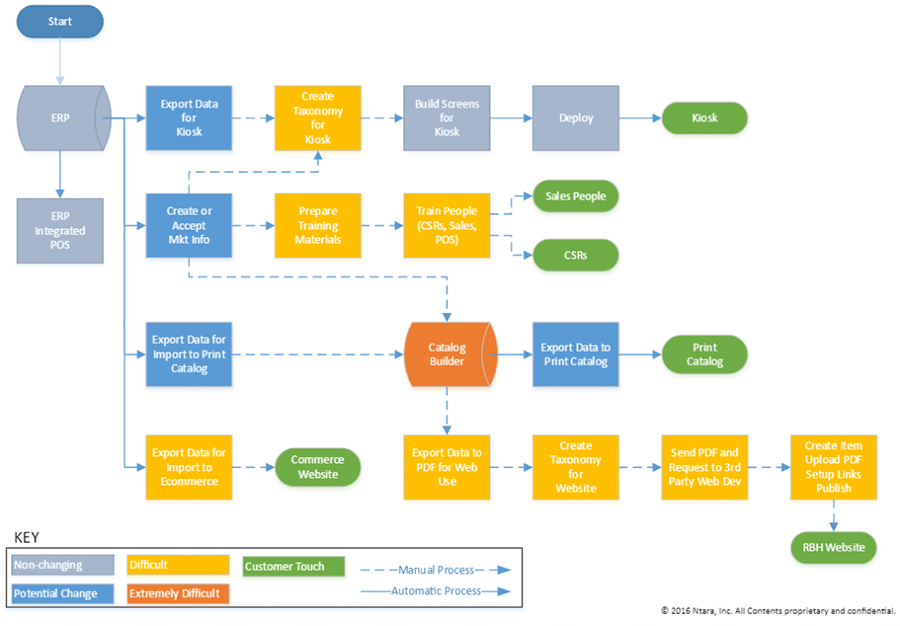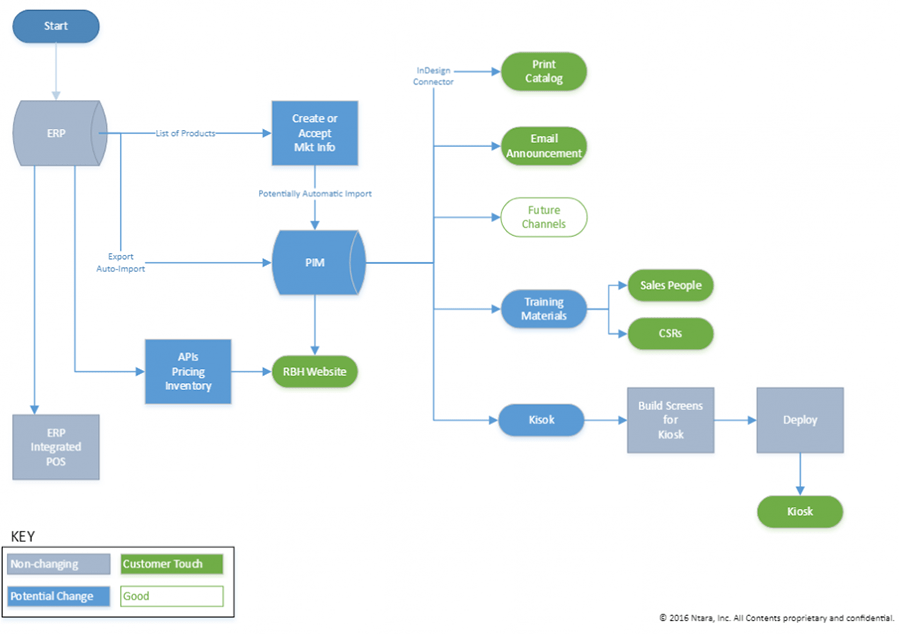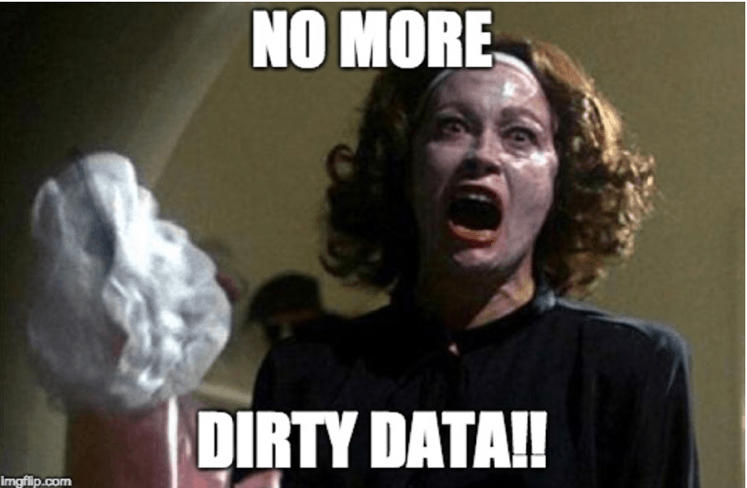The BA team includes three key roles:
Business analysts have backgrounds in analytics. They specialize in data visualization, simplifying the complex, and bridging the gap between IT and business.
Technical business analysts have backgrounds in IT. They specialize in complex data systems and have years of experience analyzing multiple, complex data types, systems, and integration scenarios.
Solutions architects have backgrounds in engineering. They specialize in documentation, development, and integrations. They speak the language of analysts, developers, designers, marketers, and anyone within the business.
Together, this team’s collective goal is efficiency. Their job is to identify risk points and develop informed solutions that will save your business time and money. They accomplish that through three main initiatives: systems & process analysis, product data analysis & cleansing, and UX & content strategy collaboration.
Systems & process analysis
What it is
If you’re incorporating a new system into your technology stack, it is critical that you understand how it fits in with all existing systems. How will data flow to and from the new system? How will that change the way you use your other systems? Who will own the system and make updates to the data or content?
EX: You’re implementing a product information management (PIM) system to standardize your product data. You have a content management system (CMS) and an enterprise resource planning (ERP) system. And you need to understand what effect a PIM implementation will have on your ecosystem.
Your business processes typically change when a new system is implemented. Sometimes these changes are forecast by the business; other times, they aren’t even on the radar. Through systems and process analysis, our BA team identifies unforeseen obstacles and develops recommendations to lessen the impact. They help ensure a smooth transition, and this analysis provides two kinds of diagrams: current state and future state.
Our process
We kick things off with stakeholder interviews. A member of our analyst team will speak with key decision makers throughout your company to identify the relevant inner workings of your business.
- What are your business goals?
- What are your challenges from both a business and technical perspective?
- What systems do you use?
- What processes exist?
We talk to people throughout your organization who work with your data and systems—product owners, data scientists, brand managers, marketing, and IT teams, etc.
- What are their daily responsibilities?
- What are the steps in each process?
- What is done manually? Automatically?
- What role does data play in their day-to-day?
- What challenges do they have with data?
We request any existing documentation that can illustrate how your systems and processes work together. Most of our clients don’t have their systems diagrammed—and that’s ok. That’s where we come in.
Our BA team will analyze all the qualitative and quantitative data collected through these processes and create a current state diagram of all existing systems. Then, they’ll create a future state diagram that shows where your new system fits and how data will flow to it, from it, and across all other systems. They’ll do the same for your processes.
EX figure 1: Go-to-market process map for manufacturing client
Large amounts of manual work required.
Processes marked in yellow and orange indicated as “difficult.”

EX figure 2: Updated go-to-market process map for manufacturing client
Majority of manual and difficult work is now handled by PIM.
PIM is now the central hub for all data flow.

Value to the customer
There are a number of ways that a systems and process analysis can benefit your business by gaining efficiency and saving money.
When your existing systems overlap, consolidation can reduce associated fees and time spent working in multiple systems. When gaps exist, adding new systems can streamline processes, saving time throughout your organization. And when manual processes exist, you can reduce the risk of human error (i.e., unnecessary and costly error) through automation.
Product data analysis & cleansing
What it is
You know the saying: Crap in, crap out. This is particularly true with massive amounts of data. Whatever systems you use, your data must be homogeneous and reliable. If you can’t ensure your data is accurate when it’s captured, you certainly can’t ensure accuracy across all systems.
Our process
Our BA team will analyze your data and look for outliers.
EX: A clothing manufacturer sells shirts, dresses, and pants.
- Does all their shirt data look the same?
- Do they use “gray” or “grey” in their color descriptions?
- Are some shirt sizes categorized small, medium, large while others are categorized by numerical size?
Much of this analysis is deductive but there are particular questions we ask as we review:
- What data does each system use?
- EX: The clothing company keeps some product data in their ERP
- Their marketing team stores all images and related PDFs on SharePoint
- The PIM should house all of this moving forward so they can easily distribute consistent information to all channels
- What fields/attributes exist?
- EX: size, color, length, gender, material, etc.
- This clothing company also sells “looks” or combinations of products
- What are the characteristics of each data field?
- EX: drop-down menu, choose all that apply, open text, etc.
- Are any fields unnecessary?
- Are any fields missing?
- Are there opportunities to reduce the number of fields?
Once we have a clear picture of the state your data, we can identify those outliers and make recommendations for cleansing. We may collapse multiple categories together. We may create new categories to better decipher between two lines of products. We may recommend switching from a manual color entry to a drop-down menu to avoid spelling errors from “gray” to “grey.” We will take careful consideration for how data is entered, transferred, and used. Our recommendations will help you get your data where it needs to be—and ensure it stays clean as you scale.
Value to the customer
If your data is inconsistent, it can be a nightmare for your teams to use. How will they know what’s your one source of truth?
It is worth the investment of time and resources to analyze and clean your data up front. That way, you can have peace of mind knowing that everyone in your organization is using the same data to describe the same products. And you can save time and money from rework in the future. Our BA team helps you establish and maintain your product data truth.
UX & content strategy collaboration
What it is
The BA team doesn’t only analyze data, systems, and processes. They also work closely with our marketing and design teams to ensure the digital experiences we create are as informed as possible.
Our process
Marketing and design consult the BA team any time they have a question about data, from initial discovery through site launch—and beyond.
EX: Marketing and design want to create individualized experiences for various visitor types on a flooring manufacturer’s website.
- The initial plan was to qualify website users with a few questions upon hitting the site:
- Who’s installing your flooring? (DIY or professional)
- What floor styles do you like? (choose all that apply)
- What colors do you like? (choose all that apply)
- Where is it being installed? (choose all that apply)
- With the answers to these questions, the site would present product options aligning with the user’s answers.
- Our BA team analyzed the client’s product data and confirmed that it was detailed enough to support this approach, and then scrubbed it for errors and inconsistencies.
- All three teams worked together to ensure the content and UX strategy, supporting designs, and data structure and systems worked together to create a seamless experience.
Value to the customer
This collaboration allows for a holistic, data-driven approach to content strategy and design. It confirms that UX and content strategies will function as planned, reducing the number of surprises that could otherwise occur during development. This saves time and money for each project, and allows for more informed, unique approaches.
What does it take to be a business analyst?
Our analysts are obsessed with efficiency. And they hate—I mean HATE—dirty data.

Why? Because they understand the problems dirty data can cause. They know that a data cleanse upfront can significantly reduce risk, misinformation, and rework in the future. They’ve seen businesses become more profitable with cleaner data. It is their job to keep this top-of-mind with every department in our agency, and with our clients.
Why choose Ntara for business analysis?
Our BA team is trained to identify tangential opportunities for efficiency. They will challenge you to think differently about your data and the processes around it.
They work closely with every department at Ntara to ensure everyone understands the nuances of each client’s systems and processes. This is critical in informing strategic decisions about each website, each piece of content, and the entire digital ecosystem.
Think about it: You want strategic consultation, and that’s exactly what this team provides. They look at your business and your data in ways you don’t expect. At Ntara, the decisions we make are rooted in data. That’s why each department works in lockstep with BA.
To learn more about working with our BA team, contact us.
Or, learn more about how to clean up your product data in this article.